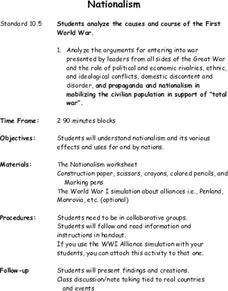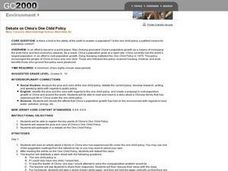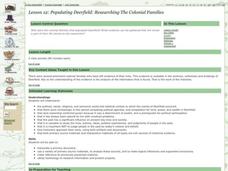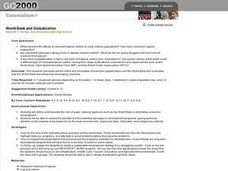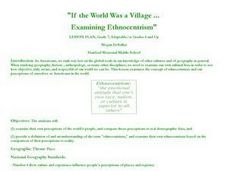Curated OER
Push and Pull Factors on Migration
Students investigate push and pull factors. In this population trends lesson, students examine primary sources that help them comprehend how push and pull factors have changed over time.
Curated OER
Lesson 3. No One Spared
Eleventh graders, in groups, explore the devastation that World War I inflicted on millions of people around the world. They write a first-hand account of the impact of World war I.
Curated OER
Invisible Invaders
Students research various epidemics that have devastated the world population focusing on the historical events taking place during the times of the epidemics and the epidemics' effects on these societies.
Curated OER
Nationalism
Tenth graders examine the causes and course of World War I. They read and discuss a handout, simulate the formation of a country, design a flag, develop a national slogan, and present their country's information to the class.
Curated OER
Post-War Suburbanization: Causes and Interpretations
In this teaching American history worksheet, students examine a primary source document regarding post-World War II suburbanization. Students discuss their impressions of the document.
Curated OER
When Enough Should Be Enough
Students take a closer look at world hunger. In this global issues lesson, students discuss hunger in African nations and determine how that might organize a school-side campaign to raise money to fight hunger through the charity...
National Wildlife Federation
Climate Solutions – A Call to Action!
The final lesson in the 21-part series on climate change focuses on energy solutions to the consumption problem. Using data specific to their school, pupils make recommendations, follow up on actions, and carefully track progress....
Curated OER
Debate on China's One Child Policy
High schoolers learn about China's One Child Policy. They read an article about a specific family's experience under the policy (not included) and research and explain the key points of the policy. They assess the pros and cons in a...
Curated OER
What Are We Going To Do About Baby Six Billion?
Students formulate and evaluate suggestions about government policy using demographic examples and projections. They examine websites and utilize worksheets imbedded in this plan.
Curated OER
Graphs and Data
Students investigate poverty using graphs. In this algebra lesson, students collect data on the effects of poverty and use different rules to analyze the data. They graph and use the trapezoid rule to interpret the data.
Curated OER
Empty Oceans
In groups of four, pupils brainstorm about seafood. They view the Monterey Bay Aquarium Seafood Watch website to examine the problems caused by the seafood industry. Learners are then brought back together to discuss what they...
Curated OER
Exploring the Global Security Matrix
Using online and newspaper resources, small groups explore the issue of global security. They answer 13 different questions on three pages that have them consider multiple risks posed by a global security system.
Curated OER
Bengali Scroll Paintings
Students, after researching diverse cultures, art forms, and celebrations around the world, explore and study India's Hindu population that celebrates Diwali with colorful scrolls. They make similar paintings and assess this cultural art...
Curated OER
The Crash Scene
Fifth graders explore geography by participating in a mapping activity. In this engineering lesson plan, 5th graders identify the differences between latitude and longitude and practice locating precise points on a globe or map. Students...
Curated OER
Graphing Population Around the World
Students define specific vocabulary necessary for understanding population data. They collect, analyze, and interpret specific data. They utilize computer programs in order to create graphs of collected data.
Curated OER
Making Connections, Linking Population and the Environment
Learners find out that all habitats have a carrying capacity. They explore how the world's human population has grown markedly in the 20th century, and that humans impact environmental health. Students investigate that people can and...
Curated OER
Population Impact on the Environment
In this population impact worksheet, students investigate how the growth in human population has contributed to certain effects on the environment. This worksheet has 5 short answer and 4 fill in the blank questions.
Curated OER
Japanese Internment Camps in the US During World War II
Eighth graders analyze the impact of the Japanese/American conflict during World War II on the Japanese American population and evaluate the consequences of government action regarding international conflict. Students demonstrate their...
Curated OER
Populating Deerfield: A Workday for Researching the Colonial families
Eleventh graders explore who were the colonial families that populated Deerfield and what evidence can be gathered that reveals a part of their life stories to the researcher.
Curated OER
World Bank and Globalization
Pupils define and describe the role of the World Bank in promoting economic development. They assess the benefits and potential damages to development programs. They evaluate how the World Bank has influenced developing countries.
Curated OER
Impact of Greek Mythology in Today's World
Students explore world logos and names of companies and relate them to Greek myths. Events real and imagined are examined and their effects on later cultures are discussed.
Curated OER
Understanding the Problems of World Hunger
High schoolers explore the issue of world hunger. They examine hunger on a personal level and explore what it means to be hungry or starving. They discuss the causes of hunger and the effects of hunger on nations.
Curated OER
If the World Was a Village...Examining Ethnocentrism
Seventh graders examine their own perceptions of world's people, compare those perceptions to real demographic data, provide definition and understanding of term "ethnocentrism," and examine their own ethnocentrism based on comparison of...
Curated OER
Six Billion and Beyond
Students consider the idea of a world with Six Billion people and subsequent results and ramifications. Then students will gather data regarding the state of these diverse nations and then create a presentation as a culminating activity.





